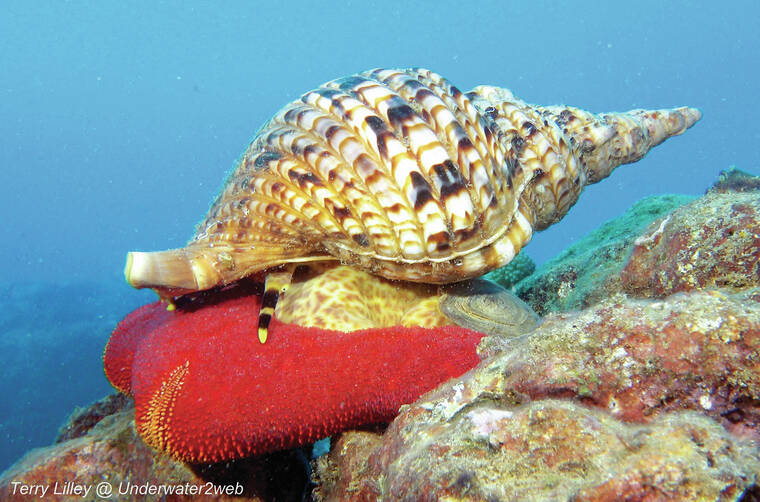I was scuba diving one day off our North Shore at about 60 feet deep, when I came upon an amazing sight and shot a video of a bright red cushion sea star.
This large 10-inch wide star looks like a pin cushion and they are quite common in certain parts of the reef. They come in many different colors from red, white, yellow to purple and they just lay motionless on the reef.
What I did not know until this dive was that this sea star eats coral and this large red specimen was on top of a cauliflower coral digesting the live coral polyps. The cushion star is native to Hawai‘i and I wondered why they do not eat all of the coral on the reef, as I have never seen a predator eat one of these starfish to keep them in some kind of balance.
I continued on my dive and when I turned around to go back to my dive kayak I visited the cushion star again and there was a large tritons trumpet shell crawling very slowly toward the red cushion star that was still feeding on the live coral.
I knew that the 20-inch long trumpet shell (pu) will eat the poisonous crown-of-thorns star, so maybe they will also eat the destructive cushion star. I started to shoot video of this slow motion attack and was amazed at what took place.
The large pu shell slowly crawled up on top of the cushion star and started to chew a hole in the top of the red star. I filmed this slow motion attack for about 10 minutes until I was low on air then I had to surface.
The next day I went back diving in the same spot just to see if either the pu shell or cushion star were still there, and the shell was still on top of the star but had sucked out about half of its insides out so the round cushion star was deflated.
I was amazed it took so long for the giant shell to eat the sea star. I shot a little more video, then came back the next day and found the flat deflated remains of the sea star dead on the reef right on top of the live coral it was feeding on. The attack pu shell was gone.
Triton trumpet shells are super beautiful and quite valuable as “blow shells,” and you often see them for sale in shell shops. But now I know just how important they are to the health of our coral reefs. If we remove too many of them from the reef the cushion stars will eat up all the live coral.
Coral reefs are extremely complex, and there are all kinds of important predator prey relationships that usually go unnoticed by divers and scientists because they happen slowly over time. If we want to preserve our coral reefs for future generations to enjoy, then we must also preserve the sea shells that play a part of keeping our reefs healthy.
You can see my slow motion pu attack video up on my YouTube at Underwater2web along with my ongoing marine life education series, or use the following link to go directly to the short, but dramatic video. https://tgilinks.com/3KiEMu8
•••
Terry Lilley is a marine biologist living in Hanalei Kaua‘i and co-founder of Reef Guardians Hawai‘i, a nonprofit on a mission to provide education and resources to protect the coral reef. To donate to Reef Guardians Hawaii go to www.reefguardianshawaii.org.


